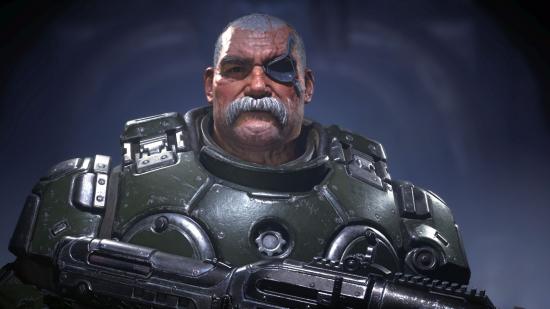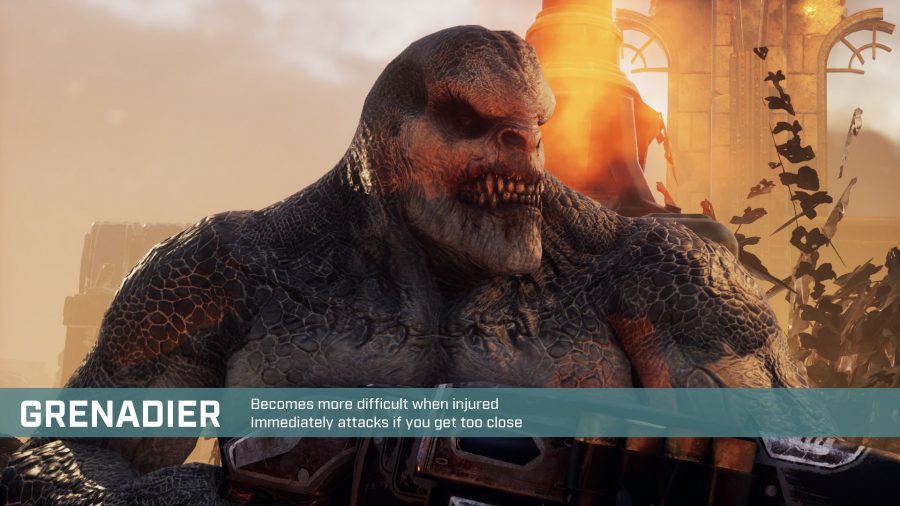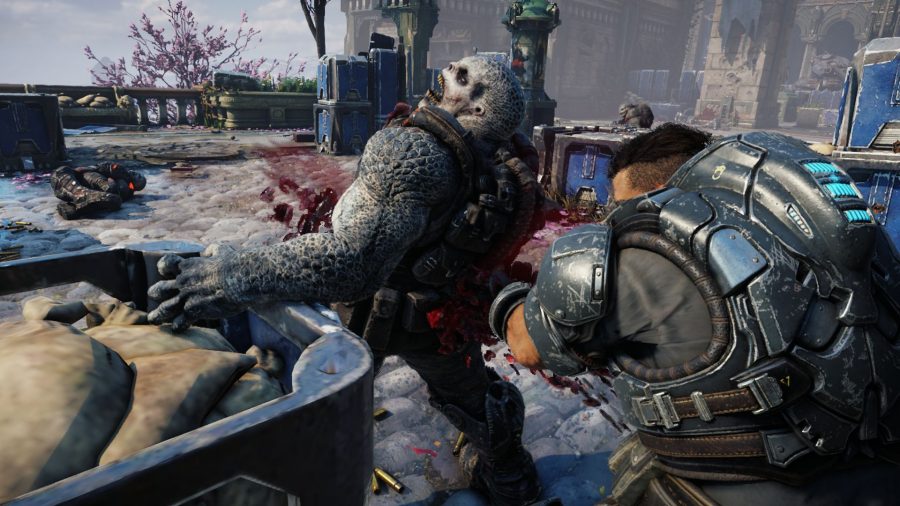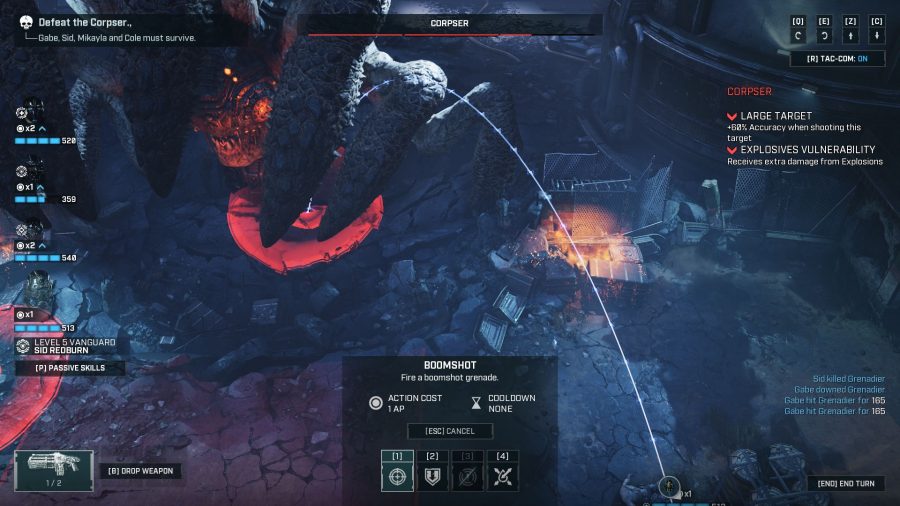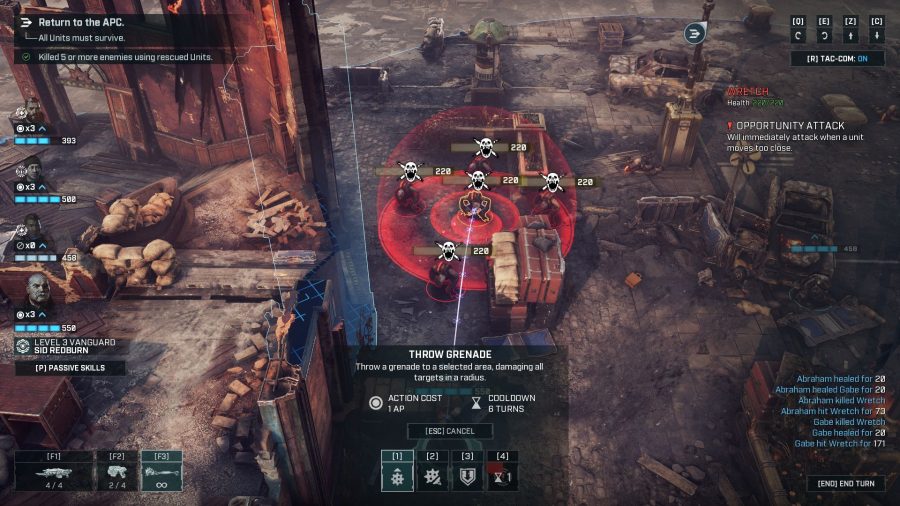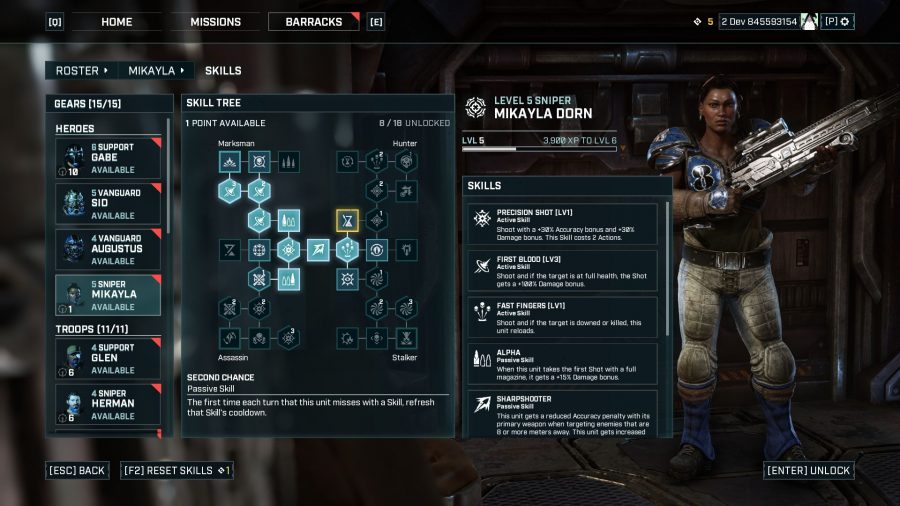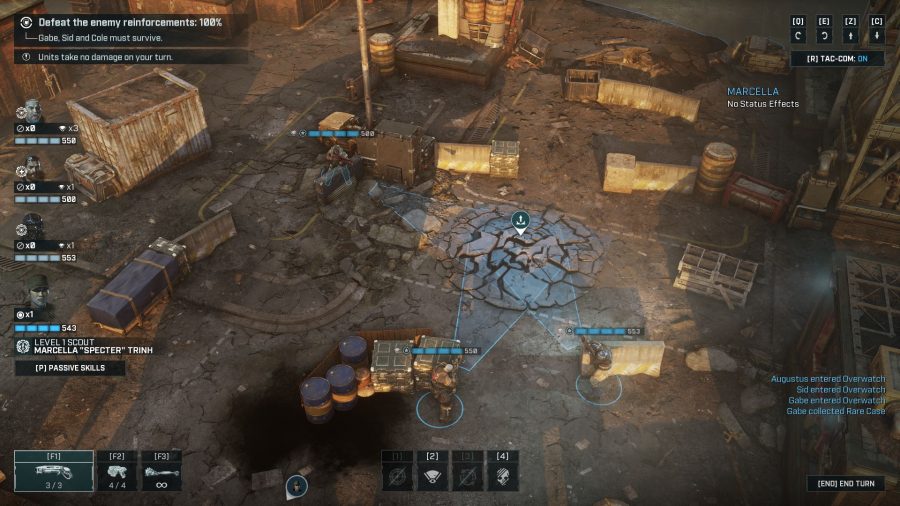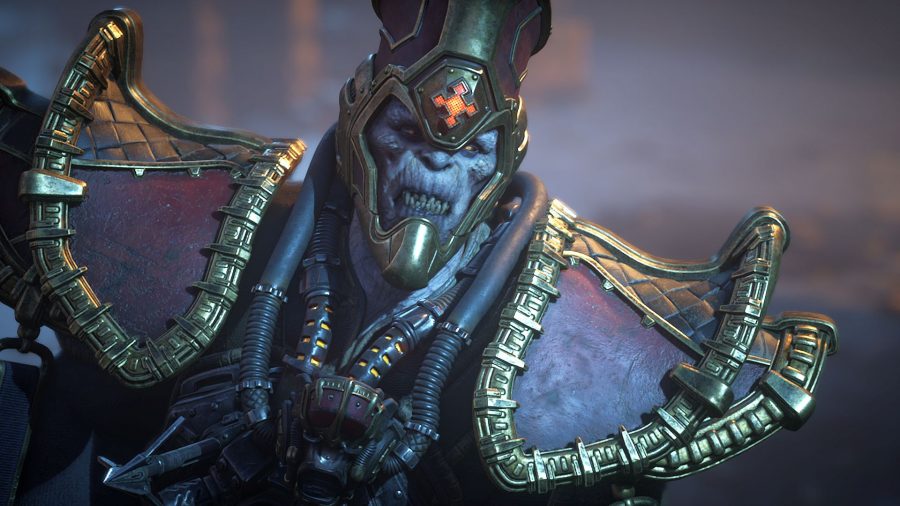Ever since 2012’s XCOM: Enemy Unknown, the formerly anaemic squad tactics genre has exploded, and most of its new entrants have wilted beneath XCOM’s shadow to some degree.
One that may not, based on my first impression, is Gears Tactics. The PC-friendly spin-off from what was once one of the Xbox’s leading console exclusives is out in a month, and making a number of carefully judged, if incremental, changes to the XCOM formula while staying true to Gears’ spirit.
I spoke with Tyler Bielman and Alex Grimbley, publishing design director and executive producer respectively at The Coalition, about why that’s not such a difficult balancing act as it first sounds. Their answers indicate why translating a heart-thumping console cover shooter to the more considered turn-based tactics genre makes a great deal of sense, why it’ll still feel like Gears anyway, and why Gears Tactics has what it takes to stand tall not just among an increasingly crowded genre, but in comparison with the modern classic that revived it eight years ago.
PCGN: Epic was working on a Gears of War Tactics game a while ago. I presume Gears Tactics has no relationship with it?
Tyler Bielman: Yeah, they had what was effectively a tech demo. We saw a video of that at one point early on, when we were still in the pitch process, but beyond that it really had nothing to do with what we were doing. We never spoke to anybody who worked on it. It was a cool video we saw once and that was it.
Was there anything in the video that stood out that you could share?
TB: To be honest I can’t even recall. It was literally over the shoulder of the creative director at the time. It was kind of neat that they had already tinkered with it a bit, but there weren’t a lot of documented learnings or anything like that which we could look to.

So you decided independently to do a strategy or tactics game based on Gears. What was behind that decision on your part?
TB: Alex and I are the publishing team within The Coalition, and our mandate is to expand the Gears brand in ways that make sense and bring it to as many people as possible. So I wrote a pitch document which said, ‘Hey, the turn-based tactics genre aligns well with the kind of game we are already: cover-based combat, squad-focused, tactical.’ That really resonated with everyone. If you look at it, kind of from a 50,000-foot perspective, a lot of things just line up. We had to prove along the way that we were interpreting Gears into tactics in a way that aligned with Gears, but that was when we kind of got rolling.
Alex Grimbley: One of the first moments where I realised we’d got it was we actually just took existing Gears and just moved the camera up. The cover-based nature of [the game] really stood out even from that first test of the camera angle. That was the first point where we realised there’s probably some magic in here that we should explore.
TB: We also put together a tabletop board game version of it first. We had a big map and we had cover, and that was also a proving point for us: could we make it feel like Gears on a table, with just paper and pencil and stuff? That was also a really cool moment for us early in development.
Were there any other Gears cornerstones that you really felt you needed to realise in this genre before you felt confident it would work?
TB: Enemy roles were a big one. You can take an enemy and just dump it into the tactics space and see what happens, but for us Gears combat is very well-defined. It’s a tactical shooter in a lot of ways, so we had to make sure that enemies had the same role they have in Gears.
For example, a Wretch is what we call a ‘flusher’; its job is to push through and shove you out of cover so that the drones, which we call ‘mirrors’, can shoot you. This is a very simple combat dynamic, and there are a lot of these dynamics happening. But once we were able to prove that a Wretch could have the same role in Tactics as in Gears, then we knew we could build a system where the combat feels like Gears, even if you may not necessarily be able to put your finger on why it does. It really is the essence of Gears boiled down to a nucleus of actions and reactions in the tactics space.
Obviously the concept for that cancelled Gears of War Tactics emerged very soon after the success of XCOM: Enemy Unknown, which still looms over the genre. Just to take XCOM as a signpost, how would you say Gears tactics differentiates itself?
TB: For us it was really important that we approach Tactics with some very firm goals in mind, and one of them was to create a faster experience. You probably noticed that there are a lot of enemies and they move quickly – we try to get through the downtime and get to your turn so you can really be playing the game. Every decision we made from the very beginning was ‘can we pace this up? Can we make it feel more action-packed?’
The other one, conceptually, is this idea of open gameplay. We don’t take place on a grid, and that allows you to go anywhere in the map you want, take any shooting angle you want, and find cover anywhere you want. We went in prototyping really hard to make sure [that would work], because it was a risk for us, and we think it paid off wonderfully because the game feels so much more fluid.
Another point I would mention under that umbrella of open combat is the action system. In a lot of tactics games you activate a unit, and you get one move action and one shoot action and that’s it. In others, if you shoot, you can’t then move. It’s very restrictive. In our game, when you activate a unit, you have three actions – and you can move three units’ worth of distance, you can shoot three times, you can mix it up, you can use skills. We wanted to create a game that was faster and more open, and gave the player more options. So you can create the builds and the squads that you want to express the way you want to win, and then we give you this open system to do it.
For more chin-stroking scheming: see the best strategy games
We also worked really hard to make sure there’s a really compelling boss fight at the end of each act that, again, feels like a Gears boss, but translated into the Tactics space – so making sure the camera feels good, the boss’s attack patterns feel good, the arena you’re fighting in makes sense. As a Gears game it was also really important to us that we hit that high bar that the franchise has for storytelling and cinematics, so I think we’re uniquely positioned in the tactics space as having the sort of character-focused, high-quality real time cinematics, with your character customisation choices in there, driving that story.
I sometimes felt that openness on the map added a touch of fiddliness when it came to issuing move and attack orders to get the angle of approach right. Is there a concern about the precision of the inputs there?
TB: Being a mouse and keyboard game there’s always going to be [a question] of how much snappiness and magnetism you put on the cursors. With respect to what you’re describing, it was really important to us that once you land that execution that you end up logically in a cover slot, because for a while, when you did that execution, you were just left standing in the open, which made the unit feel unintelligent. So there is some business to indicate to the system ‘hey, I want to end up in cover here’, or ‘I want to end up in cover here’, but that was a trade we were willing to make, because it was really important that the unit snap its way into cover.
There are definitely some moments where – like precision grenade targeting, for example – you want to be able to put that grenade exactly where you want it, so the fidelity of the game has to be high, and at some points, yeah, that can be a little tricky. Maybe very early on we heard a little bit of reporting around the controls being kind of touchy, but lately it’s been fine.
You guys are going to Xbox as well, right? Might that be an issue there?
TB: Yeah – our former studio head confirmed on Twitter in a very calculated announcement that we will be taking the game to console. We haven’t said anything else about that since then, so we don’t have anything we can say other than confirmation that we’re going to go to console.
Translating Gears into tactics and making it awesome for PC gamers was the first, most important thing, and we’re really focused on that. As we then make the move to console you can expect the same level of attention and polish to make the game amazing on whatever platform we take it to.
I saw a lot of depth in the build system compared with XCOM. What’s driven that choice?
TB: It was really important to us that we take the best of RPGs, the best of tactics, and the best of Gears and merge them together. So very early, we invested in a skill toolbox that let us build out all those skills for the classes. That work was really validated when users were coming back during user research and saying, ‘Oh my god, these cool skills!’, so we doubled down and made more of them. We really followed what the players told us was exciting.
Then if you combine that with the four mod slots on each weapon, and the three armor slots, and tons of cool equipment at different rarity levels, you really do get an RPG vibe from the metagame. That was very intentional – again, philosophically, we want to give players the tools to have an amazing time and win the way they want to win.
On that point though, there’s no base development – you can’t build facilities within the APC, which gave XCOM a few interesting strategic choices. Any reason you chose not to explore that feature?
TB: You manage your troop roster [from the base] – how many you have, which kinds of units you want – so that when you get to a chapter with side missions, you have the right mix of troops for those. But it was really just a matter of focus for us. We wanted to make sure that the most exciting parts of the game – which is the equipment, how you manage your soldiers, what your progression looks like – those were the things we wanted to focus on. We didn’t want to create a situation where you were just grinding for grinding’s sake. That was an anti-vision for us. We wanted everything to be meaningful and exciting, every step of the way.
Ok. And no multiplayer either – also a question of focus?
TB: Basically. It was a decision we made very early, and it was simply because we wanted to make the most perfect single-player tactics game we could.
AG: Yeah, it was entirely a question of focus and making sure that we really polished the things we targeted.
TB: We never had a plan to do multiplayer. It was never an option. It was just always single-player.
XCOM had a very strong overwatch, and I found it the optimal tool in many situations in Gears Tactics too. Is there any concern that it may be a little overpowered?
TB: We really wanted to reward aggression, so that execution mechanic and chaining together bonus actions, the chainsaw and bayonet charge, those mechanics are there to allow you, if you’re a kind of forward-first player, to get up into trouble and then dig yourself back out.
The main series is on PC now: here’s our Gears 5 review
The inverse of that is if you’re a conservative player and you want to skirt the map, to lead enemies around, we wanted tools for you as well. So overwatch is a tool for that; if you want to stay in one place and manage enemies with overwatch, you can definitely do that. The texture of our overwatch – the fact that it’s a cone, and you can put it out far with less accuracy or bring it in so it’s narrower, but more risky as you’re not covering as much area – we wanted it to be a very tactical overwatch. So we don’t believe it’s imbalanced in any way; we believe that it’s a counterbalance to the offensive tools we give you.
What kind of relationship or overlap does Gears Tactics have with other games in the series?
TB: It’s a canonical game, it takes place in the Gears universe. Gabe Diaz is Kate’s [the main character in Gears 5] father, so we’re going back and telling a significant chunk of his story. There’s no direct connection to any of the events of Judgement. Ukkon being the kind of master architect of the bosses – he creates the Corpser, the Brumaks and things – that was answering a question that people had had for a long time, like, ‘how do you get a giant dinosaur with a rocket launcher?’ Well, there you go. Ukkon’s the answer.
So yeah, there’s points of connection. The game actually takes place partially in a region called Vasgar, which is the same region you see in Gears 5, and there’s some easter eggs in there around the architecture if you’re really looking closely, but there’s really no connection to Gears 1 or to Judgement beyond the kind of stuff I just mentioned.
How about in a broader sense? Does Gears Tactics serve the main themes of the series or is it intended to feel a little more siloed since it’s a spinoff?
TB: Yeah, I mean, I think the theme and the canon are different. So we wanted to go back and tell kind of a throwback Gears story. It’s about soldiers on the road in a bad situation against impossible odds, and there’s the friction between the higher-ups in the government and the grunts on the ground – that exists in this game, so thematically it’s very much like the original Gears trilogy. In terms of continuity, there are points of connection that have more to do with the Diaz family, and tie into Gears 4 and 5 and Kate’s journey.
